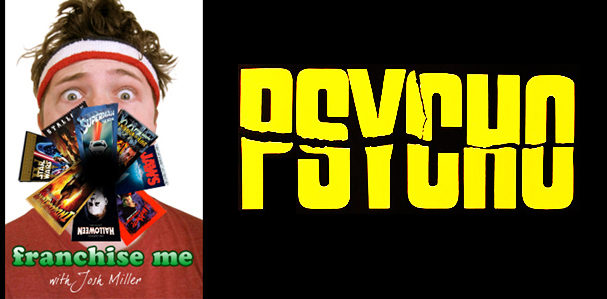
Hollywood loves a good franchise. The movie-going public does too. Horror, action, comedy, sci-fi, western, no genre is safe. And any film, no matter how seemingly stand-alone, conclusive, or inappropriate to sequel, could generate an expansive franchise. They are legion. We are surrounded. But a champion has risen from the rabble to defend us. Me. I have donned my sweats and taken up cinema’s gauntlet. Don’t try this at home. I am a professional.
Let’s be buddies on the Facebookz!
The Franchise: Psycho — following the deadly legacy of the Bates Motel and its primary caretaker, Norman Bates (Anthony Perkins). The series launched with Alfred Hitchcock’s 1960 landmark adaptation of author Robert Bloch’s novel of the same name, and spawned over the next 38 years three sequels, a failed TV series that was converted into a failed TV movie, and the most infamous remake in recent cinema history. We shall be checking in over night on all six Psycho installments.
previous installments
Psycho
The Installment: Psycho II (1983)
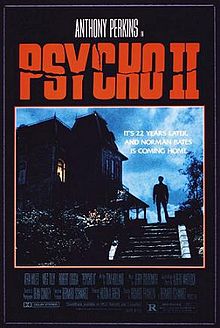
The Story:
It has been 22 years since the town of Fairvale learned that Norman Bates murdered six people (now bumped up to seven; I guess they found another body in the swamp?). Last we saw Norman he seemed crazier than ever, but Dr. Bill Raymond (Robert Loggia) believes that these 22 years in confinement have been kind to Norman’s noodle. Lila Crane (again Vera Miles), who married and then was widowed by Sam Loomis between films, disagrees. She thinks Norman is still crazy. But Raymond declares Norman sane enough to be loosed back into the world. So Norman returns home. One might assume that if you are thrown into an asylum for an indefinite period of time that the state will take away your property, but apparently Fairvale really believes in the rights of private ownership, because the hospital gives Norman back the Bates Motel — which is now being managed by the scummy Mr. Toomey (Dennis Franz), who has turned the motel into a popular destination for affairs, drugs and hooker-bangin’. Despite still owning his own business, Norman takes a job washing dishes in town to help rehabilitate himself. Here he meets an unfortunate young girl named Mary Samuels (Meg Tilly), who has no place to live. Norman invites Mary to come live with him. Unfortunately for Norman, Mary isn’t the only female house guest to arrive. His mother seems to have returned too and bodies begin to pile up. But the question remains, is it Norman going crazy again or is someone fucking with him? Or is mother real? Or a ghost? Or an evil mummy?! I vote swamp creature. That’d be totes weird!
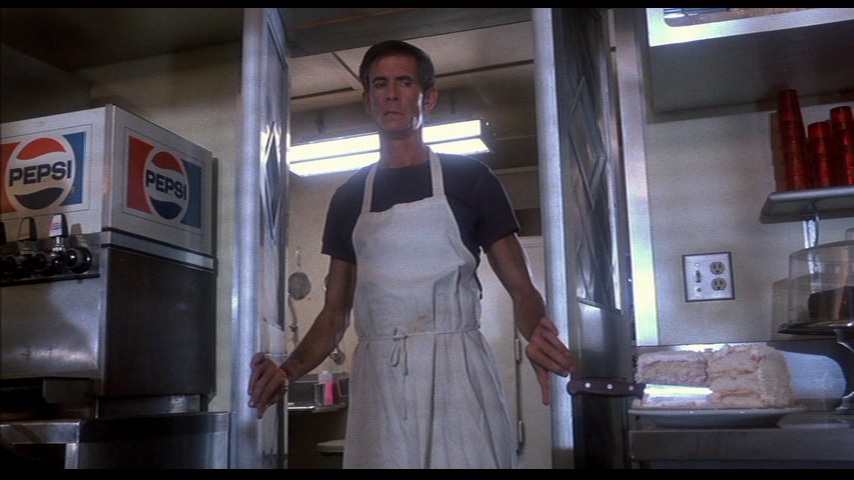
What Works:
Horror franchises are dubious by nature. After all, their very existence generally undoes the impact of the original film by revealing that our heroes’ valiant struggle to defeat the villain ultimately failed — as will likely, we now can see, the attempts of the heroes in the sequel and any subsequent sequel. In a sense, nothing matters anymore. There is a giddy appeal to this sort of shameless entertainment for its own sake (and, let’s be real, money-grubbing) that is part of the charm of the horror genre. As logically follows, the less respect fans have for the artistic merit of a horror film, the more they seem to want a sequel. When a horror film gets an air of respectability, that’s when sequels suddenly start to seem ridiculous and unwanted, as fans get touchier about said de-impactfulness. No one gave Friday the 13th Part 2 dirty looks; of course there would be a Part 2. Pscyho, on the other hand, was a seminal cross-over film, made by one of the most respected directors of all time. When a filmmaker reaches Hitchcock’s level of prestige, there is an unspoken rule that if there should be a Psycho II, he would make it. So there is something shady about two decades passing with no sequel, Hitchcock kicking the bucket in 1980, and Psycho II going into production in 1982 during the zenith of the post-Halloween Slasher-movie glut that Psycho had helped inspire in the first place. Sure, if someone like Martin Scorsese had wanted to do a sequel (like he did with The Hustler) it would be different, but with a largely unknown Australian exploitation director behind the wheel, and Anthony Perkins’ career in the toilet, this sequel has the outward class of Bambi II — it might as well be titled P$ycho II: We Love Your Money. But appearances can be deceiving. There are actually four things that make Psycho II acceptably justified:
1) Psycho was brash exploitation. It is easy to mistake it as classy now, but by 1960 standards the film had all the subtly and tact of Piranha 3D. It was lambasted by many critics for its salaciousness, on-screen violence, and failing to be anything more than a cheap gimmick. The fear with cash-in sequels to quality horror movies is that the franchise will be transformed into common horror. But Psycho was pretty damn close to common horror to begin with; it just had an odd first half that delayed reaching the horror elements. If it hadn’t been directed by Alfred Hitchcock, it probably would have already had a sequel by 1983.
2) Norman Bates doesn’t die at the end of the first film. Not only that, since he was deemed insane, we couldn’t even be sure what was going to happen to him. And the film closes with Mrs. Bates scheming inside Norman’s head, formulating a plan to make everyone think she has vanished but lurking there all the same. Hell, that’s practically a tease for a sequel! And even if Universal was waiting for Hitchcock to die, the story of Norman Bates being released from the mental institute is significantly more interesting if he has been locked up for a long, long time, as it allows for some of the residents of Fairvale to have forgiven him. Taking 22 years off was something of a happy accident.
3) Author Robert Bloch published his novel Psycho II in 1982. The film and the book are completely unrelated, but its existence was presumably the true catalyst for the film. Not Hitchcock dying. Curiously, Psycho II‘s story bears a strong resemblance to William Castle’s Strait-Jacket; screenplay written by none other than Robert Bloch.
4) The largely unknown Australian exploitation director is Richard Franklin, who was a Hitchcock devotee and got the gig because of his 1981 Rear Window inspired film, Roadgames (which starred Janet Leigh’s daughter, Jamie Lee Curtis). Franklin isn’t a Scorsese, but he is a calculated choice — one made to stay true to Hitchcock’s spirit.
Point being, this film has a far less suspicious raison d’être than one might presume. The worst thing about Psycho II is that it is a sequel to Psycho. The best thing about Psycho II is that it is wildly fun. It is naturally going to come up short in comparisons with Hitchcock’s film, but if we’re comparing it to other horror second-installments, it is pretty darn good.
Robert Bloch’s Psycho II involved Norman escaping from the institution and going on a crazy murder spree in Hollywood where a movie based on his life is being made (one has to wonder if Kevin Williamson took inspiration from Bloch’s book for Scream 2). While the gonzo fan in me kind of wishes this story had been turned into a film, sequels should be staying true to the franchise, and Bloch’s story would not have felt tonally in keeping with what audiences liked about Psycho. (Bloch’s novel was more of a devilish fuck-you to expectations and a commentary on the popularity of Hitchcock’s film, which had eclipsed its source material.) Tom Holland had just written the scripts for The Beast Within and Class of 1984 when he landed the Psycho II gig, and overall he and Franklin show a savvy appreciation for which elements to replicate and which to ignore from Psycho. It would be been eye-rolling stupid to have a new female protagonist get killed midway through the movie. Norman is the star now. We want to see his story. And there was absolutely no way to replicate the power of the first film’s final twist, but twists were certainly part of Psycho‘s fabric. We need them, or it won’t quite feel like a true sequel. To their credit, Holland and Franklin manage to give us twists at the exact same two story beats. Our first twist isn’t as big of a surprise as Marion Crane dying, but the revelation of Mary Sameuls’ true identity is still an unexpected surprise. And though the final revelation about Emma Spool’s true identity is utterly ridiculous, it is pleasing and sends the film off with a bang (or shovel thwack, rather). The whole finale is a great play on the finale of the first film, with unfortunate farce now positioning Mary in the same circumstance we previously found Norman in Psycho‘s climax — dressed as Mrs. Bates and wielding a knife just as the cops bust in and totally misunderstand what they are seeing.
Richard Franklin lacks the flourish of Brian De Palma, but he is no less of a Hitchcock acolyte. One of the more admirable aspects of Psycho II is how few wink-winky nods it has to the first film. Oh, there are many, many nods – the worst being opening the film with Psycho‘s entire shower scene; which doesn’t even fill new viewers in on the backstory – but Franklin works them into the construction of the film. At times it is hard to say what was intentional and what was just me reading into things. The first time Norman hears his mother’s voice, he drops his suitcase down the stairs. This conjured the memory of Arbogast’s death for me, though there was nothing overt in the execution to draw such a comparison. Just stairs and something tumbling down them and landing at the bottom. Even something as inevitably overt as Mary’s shower scene did not strike me as meta pandering, because of how the scene fits into the film. It plays against expectations because nothing happens to Mary. She sees someone spying on her through a hole in the wall, a hole just like the one that Norman spied on Marion Crane through. But no one kills Mary and when she comes out of the bathroom she discovers Norman downstairs playing the piano. Maybe he could have run down the stairs and started playing after she saw someone peeping, but it is questionable. And this is the moment when the plot starts to thicken and you realize this isn’t going to be an uninspired story of Norman simply going crazy again.
Franklin also does a great job of meeting us halfway between Hitchcock and 1983 Slasher films. Things have gotten a little gorier, but considering the amount of blood increasingly spilled between 1960 and 1983, the film is disproportionally restrained. And Franklin’s shot compositions and Andrew London’s editing are also very Hitchcockian without feeling disconnectingly copycat. The scene in which Mrs. Bates knifes the shit of a teen who broke into the house’s cellar encapsulates the rhythm and shot interplay of Psycho‘s famous shower scene without feeling like “here it is again, folks!” It is there for you to notice or not, depending entirely on whether or not you are the kind of person who picks up on such things. And when a desk clerk tries to listen in on an argument between Lila and Mary while a maid’s vacuum drowns out all the sound — hell, that’s a moment that would make Hitchcock proud.
Jerry Goldsmith does an admirable job of taking over for Bernard Herrmann on the score. Scores have always been my weak point with cinema, so I unfortunately don’t have much to say beyond that. But music was so very important to Psycho that we could not have possibly accepted some synth garbage here, even if it is 1983. Getting someone of Goldsmith’s caliber shows that Universal was taking the music seriously.
I don’t think Anthony Perkins delivers quite the performance that he did in the first film, but he is still good. Norman Bates is a whole new character now, and not just because he is supposedly cured of his insanity. Even though Norman became the de facto protagonist in Psycho after Marion died, he was a false protagonist in a sense, an “unreliable narrator” as they’d say in the literary world. We were following Norman’s story, but we were not privy to rather important details and scenes. Our absorption into his situation had more to do with Hitchcock’s storytelling prowess than the character of Norman Bates. Things are different now. The cards are all on the table, for us, for Norman, and for the citizens of Fairvale. There are elements to this new Norman that held the character back (which I’ll get to below), but overall the new Norman is worthy of our time and emotions. Moments when Norman is feeling confused and vulnerable, or when he’s making awkward attempts at humor and charm, are when Perkins shines. I love the way Perkins says “cutlery,” nearly having an anxiety attack as he tries to convince Mary his kitchen has no knives — “cuuuuuhhhhtlery.” Perkins also seems to have gotten lankier with age, which works extremely well for making him seem both ineffectual and creepy at the same time. Considering that there were only two shots in the entirety of Psycho that acknowledged that Norman was a crazy maniac, Perkins frankly seems like he was cast (in this film) because of his ability to play someone intimidating. Perkins’ performance did not fully click for me until Norman starts to believe that he truly has gone crazy, delivering lines like “It’s starting again” with spooky energy. But once things get clicking Perkins is excellent.
Norman is also handled nimbly by Holland and Franklin. It is Norman’s confidence in the first half of the film that he isn’t crazy that makes him seem so crazy. If he’d been skeptical, a nervous pussy immediately having no faith in is restored sanity, we’d probably start to suspect that something is up before Franklin can hit us with the first twist about Mary — which gives the rest of the film, once we know that Norman wasn’t imagining things, a great aftertaste as Norman’s confidence in his sanity tragically erodes.
This film has a great supporting cast, with fewer duds than the first film. Vera Miles was bland in the first film, but, as happens with many actors, she has gotten more interesting with age. (Boring John Gavin was off dicking around with the Reagan administration at this point, so we can’t say if he fermented similarly too.) Miles is great here and the character of Lila and her twisty subplot is really the heartbeat of the story. Her transition from powerless victim at the beginning of the film to somewhat villainous mastermind midway through is great, and Miles sells the whole thing as the believable act of a vengeful dogooder. Meg Tilly is a dream. Janet Leigh seemed sculpted by Hitchcock’s imagination: hair perfectly coiffed, torso all toned musculature, not a stray anything anywhere, she could not have looked more cranked out of a Hollywood hair&make-up room. Tilly’s look is at times almost blandly real in comparison. Her laid back sweet softness is a good counterpart to Perkins’ ropey twitchiness, at least aesthetically. And it is hard to go wrong with Dennis Franz playing a scumbag. Every second he’s on screen he holds our eye. His character of Toomey also brings in an interesting element, as Toomey is not only not afraid of Norman but is openly hostile towards him — which I think a macho man realistically would be when presented with a nebbish weirdo like Norman.
Toomey and Lila’s hostility mark a dramatic change from Psycho, and what is the most creatively viable thing about this sequel — Norman’s role as a victim. While the first film tricked us initially into believing Norman was only cleaning up after his mother, that was hardly a sympathetic or relatable position for him to take. Aiding a murderer, even your own mother, is villainous. And that was ultimately revealed to be bullshit anyway. He was a nutjob and a murderer. In real-life I would probably be on the side of Lila, but this is a movie, and when the truth comes out we learn that Norman was cured. The film has a thick persecution vibe tossed at Norman, going so far as to give him stigmata-esque cuts on his hands, which bleed during the epilogue as Norman shovels coal into his furnace — even crossing his arms over his chest in vague prayer.
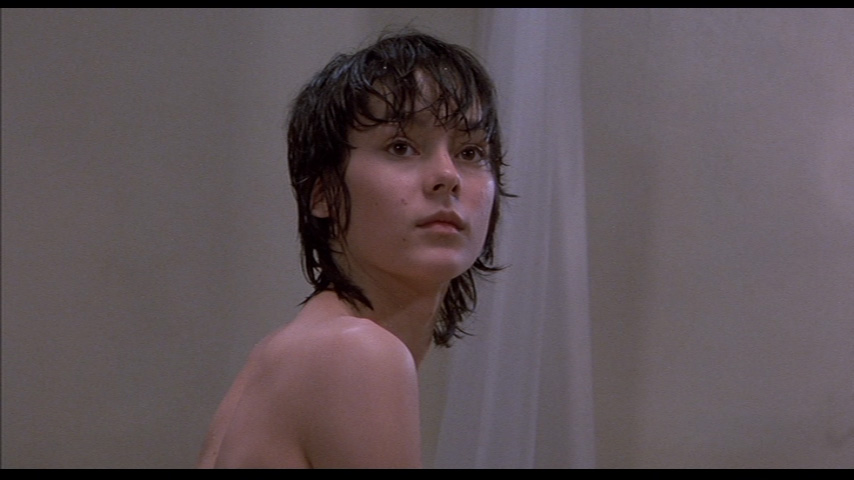
What Doesn’t Work:
Norman Bates works overall as a solid character here, but there are two basic decisions that rob him from being as stellar as he was in the first film. The first decision was to give Norman no sense of remorse. It is asking the audience a lot to accept a serial killer into our hearts (at least on any genuine level), and I never did beyond the basic acceptance I show any well-written protagonist. Part of the problem was likely that Franklin and Holland needed to move us quickly up to the point where Norman starts hearing mother again and then to the point where Mary is living with him. This is when the film gets interesting, after all. But Norman’s early scenes, especially with Dr. Raymond, don’t give any real impression that Norman feels bad about what he did. It makes sense that Raymond views Norman as a case, a broken object that he successfully repaired, but Norman seems to feel the same way too — “Oh, I was sick when I murdered those seven people, but the past is the past, right?” This is driven home by the odd moment when Norman lies to Mary about why he was in the asylum. He claims it was for poisoning his mother when he was young, leaving out all the other murders from his adulthood. Sure, that’s not the kind of thing you want to tell a chick you’re asking to move in with you, but our relationship with Norman is more important than his relationship with Mary. My acceptance of Norman had a lot more to do with me wanting to accept him, for the movie’s sake, cutting it slack, than because the movie inspired me do to so. The second decision was to make Norman confident. As I said, I liked that he was confident that he wasn’t crazy, but I didn’t like that he was confident with other people. For fuck’s sake, he’s been locked up with nurses and doctors and other wackos for 22 years. I wasn’t sucked out of the movie or anything that objectionable, but there were moments, like his initial interaction with Mary or his firing of Toomey, that felt off to me and thus made Norman a less plausible character. The realism sector of my brain told me that Norman would be a bit gun-shy interacting with “normals” after all these years.
And to that end, I think the citizens of Fairvale were a little too accommodating of Norman as well. Emma Spool’s immediate kindness ends up making perfect sense, as – SPOILER – she turns out to be Norman’s real mother. But there is no sense that the town views him as a boogeyman. We get two teens breaking into Norman’s house, but they are somehow completely unaware that he’s living there again. That may actually be the most unrealistic thing in the film, that the teens and children of Fairvale don’t know that a serial killer – surely one of the most famous serial killers in modern history within this reality – has returned to their quaint little hamlet. People know everything in small towns. Kids should be throwing eggs at his house. Frankly Toomey ends up coming across as the only sane person in town for harassing Norman, and he’s only doing it because he got fired. There was a missed opportunity for some believable drama here. Norman gets off too easy in the beginning.
I love Robert Loggia. He is good in the film, but somewhat wasted as far as what Dr. Raymond requires of him — which is almost nothing. For how much the character is in the film, Raymond is rather boring. I’m always happy to see Loggia, but it feels like a waste when he doesn’t get to chew some scenery.
Franklin and Holland at times seem a little careless with details while they’re swinging for the fences. So did Hitchcock, but, well, he was Hitchcock. It isn’t exactly fair to critique a movie based on how well it holds up to repeat viewing, but I’ve seen the film before so it also isn’t fair, objectively, to cut it a blank check just because I like it. Mary’s attitude in the first half of the film isn’t as believable when you already know she’s conning Norman. She’s a young woman, trying to drive a very tall man who murdered seven people insane enough that he gets locked up again, with only her elderly mother backing her up (and she’s not even always near by). I can accept that she has taken on this mission. It is harder to accept how relaxed and unconcerned she seems. And then people start to disappear. Okay, she doesn’t believe Norman had anything to do with it, but something fucking weird is going on, right? This is a minor critique, as the film works just dandy regardless, but this nonetheless struck me rewatching now.
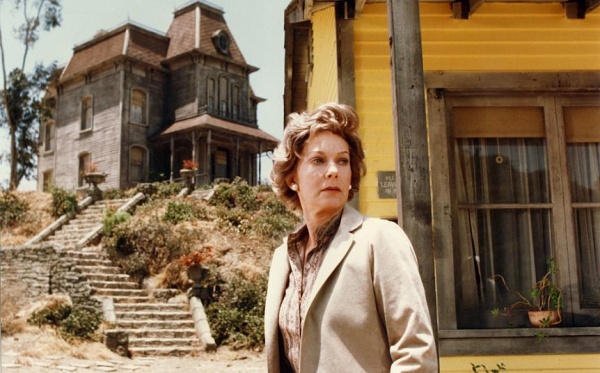
Body Count: 6
Best Kill: Well, really, the below shoveling of Emma Spool is arguably the best, but I want to give a shout out to the way Dr. Raymond bites it. For one thing, I like that it is an accident, Mary stabbing him when he attacks her (cause he thinks she’s a villain). She stabs him in the chest at the top of the staircase. Now, you might think this will lead to a repeat of the Arbogast death. Nope. Dr. Raymond falls off the side of the banister, and somehow manages to land directly on the knife sticking out of his chest when he hits another banister below. The amount of bad luck happening in this ten second window is quite unfortunate.
Best Norman Line That Really Should Have Tipped Someone Off: Said to Mary. “I don’t kill people anymore.”
Best Mrs. Bates Line: Written on a waitress’s food order. “Don’t let that whore into my house again.” The fact that it is written on a food order is what makes it delightful.
Stupidest Line: While Mary cradles Norman, he tells her she smells like the toasted cheese sandwiches his mother used to give him. Mary tells Norman to remember the good things about Mrs. Bates. Norman: No, the doctors took them all away. Along with everything else. (breaking down) Except — except those sandwiches.
Does the Twist Ending Hold Water: Eh, sort of. In as much as any total retconning can. But it doesn’t undermine too much about the original film or Norman’s backstory.
Should There Be a Sequel: I think this would have been a great place to stop. The curiosity we were left with at the end of the first film was nicely satiated. I don’t have the same feeling here, as anything following this will simply be repeating Psycho — Norman is crazy again and he has a mummified corpse of an old woman hanging around telling him to do bad things. It is going to be incredibly hard to do much with that without resorting to further retconning or lowering the franchise to rote Slasherism.
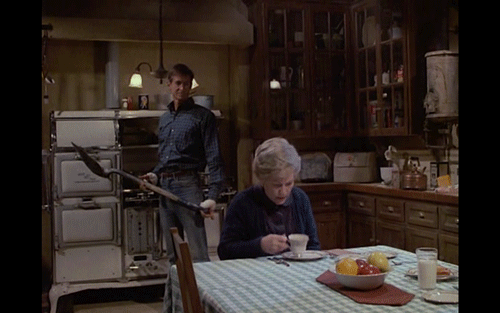
Up Next: Psycho III
DISCUSS THE FRANCHISE ON THE BOARDS
previous franchises battled
Critters
Death Wish
Hellraiser
Home Alone
Leprechaun
The Muppets
Phantasm
Planet of the Apes
Police Academy
Rambo
Tremors